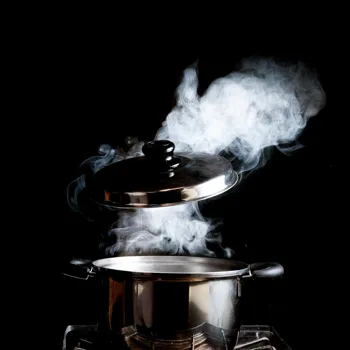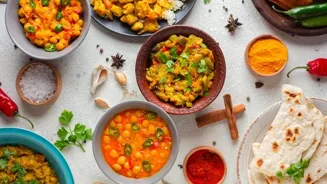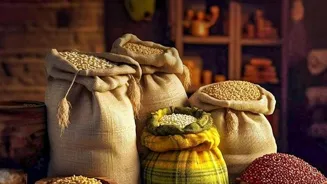Unraveling the Chemistry of Cooking: How Science Transforms Food. Dive into the magic of culinary chemistry!
We Indians love our food, no doubt! From the simplest dal chawal to the most elaborate thali,
each dish is a symphony of flavors and textures. But have you ever stopped to think about what actually happens to the ingredients when you cook them?
It's not just magic; it's science – specifically, chemistry! Cooking is essentially a series of chemical reactions that transform raw materials into the delicious food we enjoy. Let's delve into the fascinating world where art meets science in the kitchen.
The Maillard reaction transforms food with complex flavors
One of the most important chemical reactions in cooking is the Maillard reaction. This is what gives browned food its distinctive flavor and aroma. Think of the golden-brown crust on a roti or the toasty edges of a perfectly cooked idli.
The Maillard reaction happens when amino acids (the building blocks of proteins) and reducing sugars (like glucose and fructose) react at high temperatures. This reaction creates hundreds of different flavor compounds, which contribute to the complex taste of cooked food.
So, the next time you enjoy that crispy dosa, remember the Maillard reaction is hard at work! It is a great example of how heat can transform simple ingredients into something special.
Maillard reaction enhances flavor at specific temps & acidity levels
The Maillard reaction happens best at temperatures between 140°C and 165°C (284°F and 329°F). That's why simply boiling food doesn't usually produce the same rich, browned flavours. Also, the acidity of the food affects the reaction.

More alkaline (less acidic) conditions promote the Maillard reaction. That is why some recipes call for adding a pinch of baking soda to help with browning. But remember, too much baking soda can affect the taste, so use it carefully!
Heat drives chemical reactions in cooking, affecting molecules and proteins
Heat is the driving force behind many of the chemical reactions that occur during cooking. It provides the energy needed to break down bonds between molecules and form new ones. For example, when you boil vegetables, the heat softens their cell walls, making them easier to chew and digest.
Heat also affects proteins. At certain temperatures, proteins unravel and change shape; this is known as denaturation. This process is essential for cooking. Too little cooking and the protein remains folded, making the food tough.
Too much cooking and the protein becomes overcooked, resulting in a dry texture. Knowing how different foods respond to heat is crucial for successful cooking. Consider paneer, cooking it for too long turns very chewy because of the proteins becoming overcooked.
Acids and alkalis in cooking: roles, effects, and balance
Acids, like lemon juice or vinegar, play several important roles in cooking. They can tenderize meats, prevent discoloration of certain fruits and vegetables, and add a tangy flavor to dishes.
For example, adding lemon juice to a fruit salad helps prevent the fruits from turning brown since it slows down oxidation reactions. Acids can also break down proteins, making them more digestible. Alkalis, like baking soda, can be used to neutralize acids, soften vegetables, and promote browning.
For example, adding a pinch of baking soda to the water when cooking chana (chickpeas) helps soften their skins, making them cook faster and more evenly. Understanding the effects of acids and alkalis can help you achieve the desired texture and flavor in your dishes.
Using too much acid can make food sour, however, and too much alkali will leave it with a strange, metallic taste.
Emulsions mix oil and water using emulsifiers, preventing separation
An emulsion is a mixture of two liquids that don't normally mix, like oil and water. Think of salad dressings or mayonnaise. These mixtures are stabilized by an emulsifier, a substance that has both water-loving (hydrophilic) and oil-loving (hydrophobic) properties.
Emulsifiers allow the oil and water to stay mixed together instead of separating. Common emulsifiers include egg yolks, mustard, honey, and some proteins. When making an emulsion, it's important to add the oil slowly while whisking constantly.
This helps to break the oil into tiny droplets and disperse them evenly throughout the water. If you add the oil too quickly, the emulsion will likely break, and the oil and water will separate. One popular example of emulsions in Indian food is Raita.
Milk and spices come together because of the emulsion process.
Spices in Indian cuisine have flavor and health benefits
Spices are an integral part of Indian cuisine. They add flavor, aroma, and color to our dishes. But spices are more than just flavor enhancers; they also contain compounds that can have various effects on our bodies. For example, turmeric contains curcumin, which has anti-inflammatory properties.
Ginger contains gingerol, which can help with digestion. Chilies contain capsaicin, which can boost metabolism. The flavor of spices changes when they are heated, and some spices release their aroma better when toasted or bloomed in oil before adding them to a dish.
Learning how to use spices effectively can elevate your cooking to a whole new level. It is a mixture of art since you can choose your spicing combination and science since you should understand when and how to add these accordingly.
Experiment and learn in cooking to create unique dishes
Cooking is not just about following recipes; it's also about experimentation. Understanding the basic principles of food chemistry allows you to adjust recipes, troubleshoot problems, and create your own unique dishes. Don't be afraid to try new things in the kitchen!
Observe what happens when you change an ingredient or cooking method. Keep track of what works and what doesn't, and learn from your mistakes. With a little knowledge of science and a lot of practice, you can become a master of the culinary arts.
So, put on your apron, grab your spatula, and get ready to explore the exciting world of cooking science!
AI Generated Content. Glance/InMobi shall have no liability for the content









